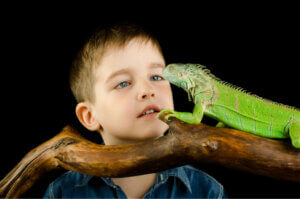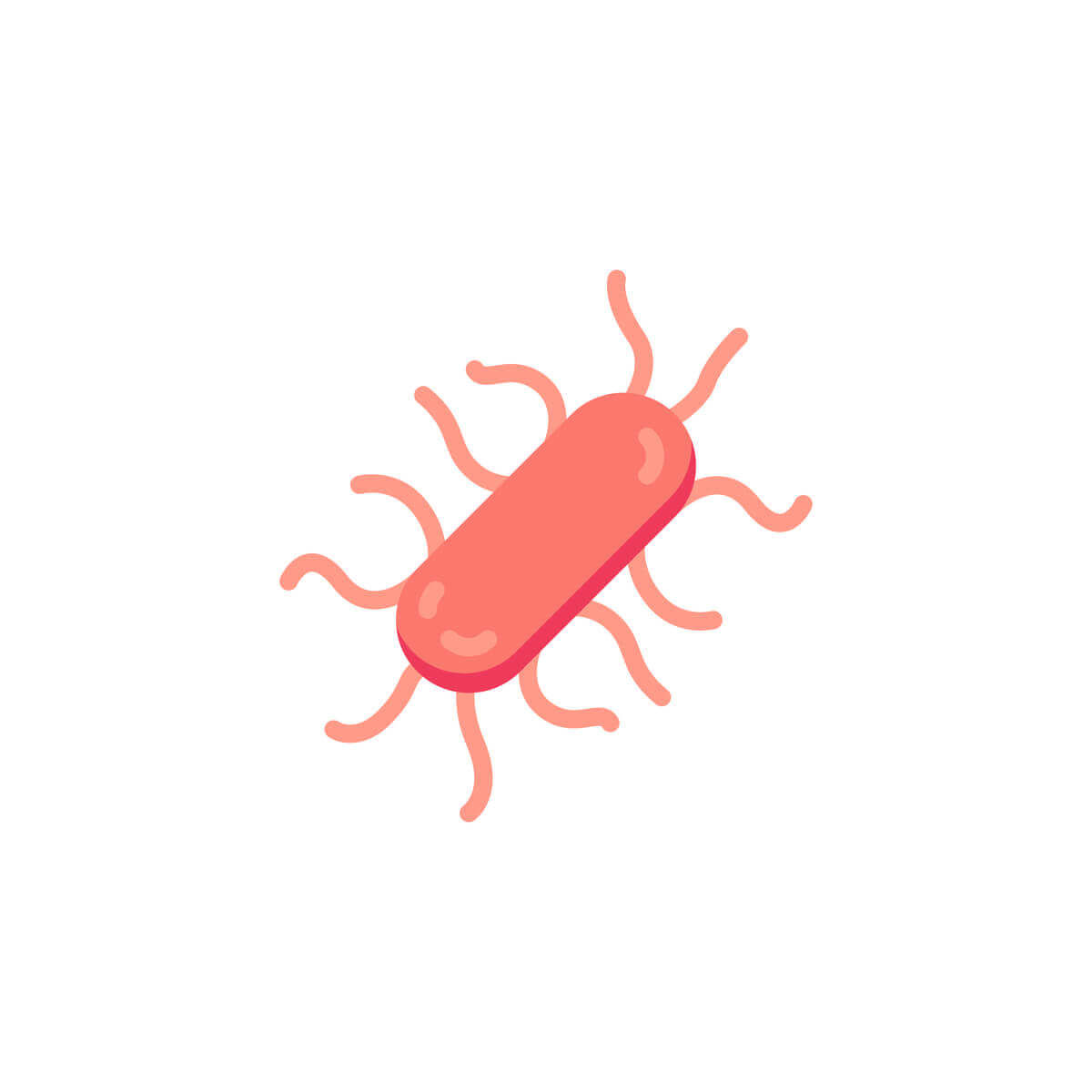Exotic Reptiles and Amphibians Can Cause Salmonella

Salmonella is a disease transmitted by enterobacteria of the genus Salmonella. Some species of this taxon live naturally on reptiles and amphibians. For this reason, it’s important to take certain cautions with the handling of almost all exotic species because they can cause salmonella. This is especially true of those that come from wild capture.
The same animals can carry several strains of salmonella in their bodies. Luckily, salmonella is susceptible to many disinfectants and also to heat. So, by being careful during the handling of reptiles and amphibians, any experienced tutor can avoid infection.
Can reptiles and amphibians cause salmonella?
Salmonella inhabits the intestine of infected reptiles – even if they don’t display symptoms – and spreads mainly through the fecal-oral route. This is because the feces of the infected animal continuously or intermittently eliminates the potentially pathogenic bacteria.
The feces of other reptiles and contaminated food, water, or substrate can infect a reptile or amphibian. In turn, salmonella reaches humans by handling the reptile or amphibian or by any object, water, or food contaminated by the feces.
These bacteria can survive for long periods of time in the environment. This especially true if the climate is warm and humid, as amphibian and reptile terrariums usually are. In fact, even after the animal has been removed from the facility, the bacteria can remain.
Cleaning and feeding materials can also contain bacterial load for some time and therefore cause salmonella.

Salmonella in humans
After infection with salmonella, the first symptoms may appear between 6 and up to 70 hours after contact. Then, they may last from 24 hours to 12 days. The main sign of salmonella is gastroenteritis, which can occur with varying degrees of severity. Asymptomatic infections can also occur.
With the typical gastroenteritis of the salmonella, other associated symptoms appear. Among them, we find the following:
- Nausea and vomiting
- Abdominal pain
- Diarrhea
- Headaches
- Fever and chills
- Myalgia, ie, characteristic muscle pain
In many cases, the symptoms remit spontaneously in 1-7 days. However, the infection can be more severe in very young, elderly, or immunosuppressed people. In spite of this, in very few cases, it becomes fatal.
The treatment of the salmonella consists of the administration of different antibiotics, because many strains are resistant to one or more of them. If you’re the owner of a reptile or amphibian and you feel symptoms similar to those we’ve described, it’s important that you see your doctor.
You’ll need to tell them what animal you have in your house in order to look for the diagnosis and correct treatment.
How you can prevent salmonellosis
There are no vaccines to prevent the disease, but you can follow a series of recommendations to prevent salmonella infections associated with reptiles and amphibians. Here’s a list of the most important tips to keep you safe without missing out on the enjoyment of your exotic pet:
- Wash your hands thoroughly with soap and water – and often – after handling reptiles or their cages.
- Change your clothes after having contact with animals. This is especially important before interacting with small children as well as the elderly or people who are immunosuppressed. All are more susceptible to complications.
- Avoid eating, drinking, or smoking while handling reptiles or their enclosures.
- Don’t allow reptiles to roam freely around the house.
- Keep animal terrariums away from the kitchen and other food preparation areas.
- Don’t use the kitchen sink for bathing reptiles or cleaning their dishes, terrariums, or accessories. If you do use it for this purpose, you must completely disinfect it after each use.
- As obvious as it sounds, it’s important not to kiss or share food with reptiles or amphibians.
Can reptiles and amphibians get sick from salmonella?
As a precaution, you should always assume that reptiles and amphibians can carry salmonella and follow the above guidelines to prevent infection. There are documented cases in iguanas, turtles, lizards, snakes, chameleons, frogs, salamanders, and many other reptiles and amphibians.
Even so, the disease in these animals is very rare. The period of incubation is very variable and, what’s more, the symptoms only appear when the animal is very stressed or has another disease.
There are tests to detect salmonella in these animals and you can consult an exotic pet veterinarian if you need to. Treatment with antibiotics for reptiles isn’t recommended, as it usually worsens the clinical picture of the sick animal.

Salmonella is a disease transmitted by enterobacteria of the genus Salmonella. Some species of this taxon live naturally on reptiles and amphibians. For this reason, it’s important to take certain cautions with the handling of almost all exotic species because they can cause salmonella. This is especially true of those that come from wild capture.
The same animals can carry several strains of salmonella in their bodies. Luckily, salmonella is susceptible to many disinfectants and also to heat. So, by being careful during the handling of reptiles and amphibians, any experienced tutor can avoid infection.
Can reptiles and amphibians cause salmonella?
Salmonella inhabits the intestine of infected reptiles – even if they don’t display symptoms – and spreads mainly through the fecal-oral route. This is because the feces of the infected animal continuously or intermittently eliminates the potentially pathogenic bacteria.
The feces of other reptiles and contaminated food, water, or substrate can infect a reptile or amphibian. In turn, salmonella reaches humans by handling the reptile or amphibian or by any object, water, or food contaminated by the feces.
These bacteria can survive for long periods of time in the environment. This especially true if the climate is warm and humid, as amphibian and reptile terrariums usually are. In fact, even after the animal has been removed from the facility, the bacteria can remain.
Cleaning and feeding materials can also contain bacterial load for some time and therefore cause salmonella.

Salmonella in humans
After infection with salmonella, the first symptoms may appear between 6 and up to 70 hours after contact. Then, they may last from 24 hours to 12 days. The main sign of salmonella is gastroenteritis, which can occur with varying degrees of severity. Asymptomatic infections can also occur.
With the typical gastroenteritis of the salmonella, other associated symptoms appear. Among them, we find the following:
- Nausea and vomiting
- Abdominal pain
- Diarrhea
- Headaches
- Fever and chills
- Myalgia, ie, characteristic muscle pain
In many cases, the symptoms remit spontaneously in 1-7 days. However, the infection can be more severe in very young, elderly, or immunosuppressed people. In spite of this, in very few cases, it becomes fatal.
The treatment of the salmonella consists of the administration of different antibiotics, because many strains are resistant to one or more of them. If you’re the owner of a reptile or amphibian and you feel symptoms similar to those we’ve described, it’s important that you see your doctor.
You’ll need to tell them what animal you have in your house in order to look for the diagnosis and correct treatment.
How you can prevent salmonellosis
There are no vaccines to prevent the disease, but you can follow a series of recommendations to prevent salmonella infections associated with reptiles and amphibians. Here’s a list of the most important tips to keep you safe without missing out on the enjoyment of your exotic pet:
- Wash your hands thoroughly with soap and water – and often – after handling reptiles or their cages.
- Change your clothes after having contact with animals. This is especially important before interacting with small children as well as the elderly or people who are immunosuppressed. All are more susceptible to complications.
- Avoid eating, drinking, or smoking while handling reptiles or their enclosures.
- Don’t allow reptiles to roam freely around the house.
- Keep animal terrariums away from the kitchen and other food preparation areas.
- Don’t use the kitchen sink for bathing reptiles or cleaning their dishes, terrariums, or accessories. If you do use it for this purpose, you must completely disinfect it after each use.
- As obvious as it sounds, it’s important not to kiss or share food with reptiles or amphibians.
Can reptiles and amphibians get sick from salmonella?
As a precaution, you should always assume that reptiles and amphibians can carry salmonella and follow the above guidelines to prevent infection. There are documented cases in iguanas, turtles, lizards, snakes, chameleons, frogs, salamanders, and many other reptiles and amphibians.
Even so, the disease in these animals is very rare. The period of incubation is very variable and, what’s more, the symptoms only appear when the animal is very stressed or has another disease.
There are tests to detect salmonella in these animals and you can consult an exotic pet veterinarian if you need to. Treatment with antibiotics for reptiles isn’t recommended, as it usually worsens the clinical picture of the sick animal.

All cited sources were thoroughly reviewed by our team to ensure their quality, reliability, currency, and validity. The bibliography of this article was considered reliable and of academic or scientific accuracy.
- Centros para el Control y la Prevención de Enfermedades. Cuidado con los reptiles y anfibios como mascotas.
- The Center for Food Security and Public Health. Salmonelosis asociada a los reptiles, 2013.
This text is provided for informational purposes only and does not replace consultation with a professional. If in doubt, consult your specialist.








